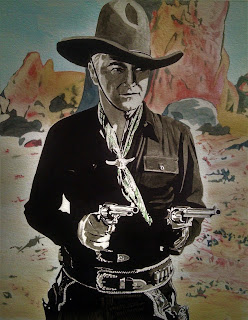LEGENDARY HEROES #9
HOPALONG CASSIDY
Hopalong Cassidy was created in 1904 by author Clarence E. Mulford. Mulford was born in Streator, Illinois and wrote 28 novels and numerous short stories about Hopalong and the Bar 20 Ranch. The first story appeared in "Outing" magazine in 1904, and the last appearance was his 1941 novel "Hopalong Cassidy Serves a Writ". The character of "Hoppy" was a grubby, irritable, foul-mouthed, crusty old coot who had a wooden leg that caused him to "hop", hence his nickname. The literary Cassidy was nothing at all like the film version that popularized him. The film series began in 1935 with William Boyd playing Hopalong as a clean-cut hero who never drank anything stronger than sarsaparilla. Whether he was driving a herd of cattle for the Bar 20 or lending a helping hand to those in need, Hopalong Cassidy was always on the side of the righteous. There were no other actors who portrayed Hopalong which made William Boyd indelibly associated with the character, and he portrayed the character in 66 movies over the years. 66 movies!
Despite the old belief that good guys always wore a white hat, Hopalong was clad entirely in black and rode a white horse named Topper. The films were originally released by Paramount and proved to be successful. United Artists later took over distribution, but in 1944 it was decided to cancel the series. William Boyd felt that there was still popular demand for the cowboy hero and he subsequently mortgaged everything he owned in order to raise $350,000 to purchase the character rights from author Mulford and the backlog of movies that he had made. Boyd resumed production in 1946 with lower budgets and continued filming through 1948 when "B" westerns were being phased out by the major studios. Boyd eyed television as his potential future and approached NBC with the idea of a series. The network started out by airing the old movies which proved to be very successful and they agreed to a weekly series. Hopalong Cassidy was so popular that NBC couldn't wait for Boyd to begin production on the new show, and instead they edited the feature films to TV broadcast length and launched the "Hopalong Cassidy" TV series on June 24, 1949. It became the first network western series.
The series and character were so popular that Boyd in his "Hoppy" outfit was featured on the covers of Life, Look, and Time. Boyd's gamble paid off and he earned millions from merchandise licensing and endorsements. In 1950 Hopalong Cassidy became the first character to be featured on a children's lunchbox causing sales at Aladdin to jump from 50,000 sold a year to 600,000! In 1950 more than 100 companies began manufacturing $70 million worth of Hopalong Cassidy products that included children's dinnerware, pillows, roller skates, soap, wristwatches by Timex, and penknives. William Boyd made $800,000 that year off of all the endorsements. This in turn created a demand for movies in the theaters and Boyd hired distributor Film Classics to make new prints of his old films and re-issue them to movie houses. Another enterprise was through home-movie company Castle Films which produced condensed versions of the old Paramount "Hoppy" films and released them in 16 mm and 8 mm format to the home movie enthusiast. These films, and the projectors, were sold through 1966. The TV series was ranked #7 in popularity in 1949, #9 in the 1950-1951 season, and #28 by the end of 1952. The success of Hopalong on TV inspired other westerns aimed at a juvenile audience with Gene Autry and Roy Rogers.
The success of the TV show resulted in a radio series that featured Boyd and debuted on the Mutual Broadcasting System on January 1, 1950. At the end of September the show moved to CBS radio where it remained until 1952. A comic strip was released to newspapers in 1949 by Mirror Enterprises, drawn by Dan Spiegle. The strip was purchased by the larger King Features in 1951 and ran until 1955. Fawcett ran a series of comic books from 1946-1953, and when they ceased publication DC comics took over in 1954 and published the title until 1959. Not to be outdone by the folks at Disneyland, the Hoppyland amusement park opened in Venice, California on May 26, 1951 on 80 acres of land that Boyd was an investor in. It featured a roller coaster, miniature railroad, pony rides, a boat ride, Ferris wheel, and carousel along with a picnic area and recreational facilities. Boyd regularly appeared at the park to promote Hoppyland, but it proved to be one of the only unsuccessful ventures associated with Hopalong Cassidy. The park closed in 1954. William Boyd and the 1950s would always become associated with Hopalong Cassidy. Boyd estimated that over the years in which he played the character, that he had fired his revolvers over 30,000 times, had killed at least a hundred varmints, wore out 12 suits and 60 ten-gallon hats, rode Topper more than 2000 miles, and rescued a score of heroines but never kissed a one of them. William Boyd died in 1972.


.jpg)

.jpg)
Comments
Post a Comment